REGAN Vest: Inside Denmark's secret nuclear bunker
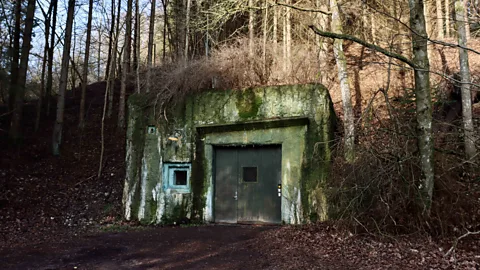 Adrienne Murray Nielsen
Adrienne Murray NielsenA top-secret atomic bunker has opened to the public in Denmark. Built to withstand a nuclear attack, it's now an astonishing subterranean museum that sheds light on Cold War paranoia.
Hidden in northern Jutland's Rold Forest, some 400km north-west of Copenhagen, is the sprawling bunker complex of Koldrigsmuseet REGAN Vest (The Cold War Museum REGAN West). Secretly built in the 1960s at the height of Cold War tensions, this is where the Danish government and even the queen would have been evacuated if nuclear war had broken out.
The plan was to run the country from inside this shelter, 60m below ground, and its very existence was kept hushed for decades until it was finally revealed in 2012. After years of preparations, it opened to the public for the first time in February 2023 as a museum. Only 50,000 visitors are permitted annually, and access has been limited to small groups of 10 on 90-minute guided tours that explore 2km of the labyrinthine bunker system. It's an eye-opening journey into the heart of a Cold War-era time capsule.
Stepping out of the train station in the small town of Skørping, I jumped straight into a taxi for the short ride to Rold Forest. The local driver had never heard of the mysterious bunker, and with no phone signal, we ended up driving around in circles trying to find it. Luckily, before long we chanced upon the road leading towards a cluster of dark metal and glass buildings partly obscured in the hillside that's home to the smart new visitor centre.
Under towering woodland and a brilliant blue sky, I trampled along a short track to the bunker's entrance, a spot that would once have been guarded by policemen armed with pistols and hand grenades. The weathered concrete doorframe had turned green with moss and damp, and it was so ordinary looking that the expansive tunnel network it concealed was all the more astounding.
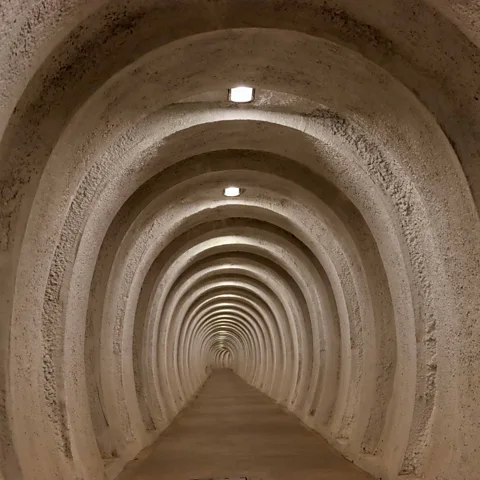 Adrienne Murray Nielsen
Adrienne Murray Nielsen"This was part of keeping it secret," said Bodil Frandsen, museum curator and historian, as she welcomed me inside with her colleague, Lars Christian Nørbach, North Jutland Museums' director.
Entering the tunnel, I felt as though I was stepping into a secret parallel universe. I'd never seen anywhere quite like it.
"Listen," said Nørbach, as the door thudded shut, sealing off the last rays of natural light and sending an echo reverberating down the 300m-long tunnel ahead of us.
My sense of anticipation only grew as we continued along the passageway that was carved into the chalk and limestone hillside. What was only a few minutes' walk felt much longer as we tracked the curving, ribbed walls that were designed to slow down the pressure wave of a nuclear blast.
Eventually we reached a pair of heavy, air-tight doors that marked the beginning of the actual bunker. Our first stop was the engine room, where diesel generators would keep the facility running. Once sealed off from the outside world, there would be sufficient electricity, recycled air and other supplies for 10 days, explained Frandsen, likening it to a submarine, "just on land".
The Cold War was a period of acute political and military tension between Western and Eastern blocs, aligned with the US and Soviet Union, that spanned from shortly after World War Two until the early 1990s, triggering a nuclear arms race. After Soviet testing of a potentially catastrophic hydrogen bomb – and later the Cuban Missile Crisis – fears of Armageddon were fuelled further.
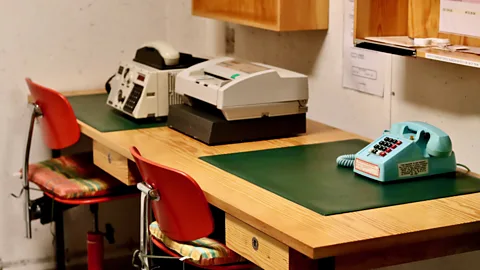 Adrienne Murray Nielsen
Adrienne Murray Nielsen"You'd never seen a weapon like it," posited Frandsen. "It was just way stronger and way more devastating. It demanded a new way of thinking and planning."
A NATO member since 1949, Denmark's location at the mouth of the Baltic Sea was (and still is) strategically important, but its proximity to the Iron Curtain also made it vulnerable, which is why the country prepared for the worst. Construction of REGAN Vest began in 1963 and was completed five years later.
The resulting nuclear-proof bunker was a staggering 5,500sq m behemoth, shaped like two large, connected rings, each with an upper and lower floor, and more than 230 rooms that would house around 350 personnel. Mostly these would be ministers and civil servants, part of a slimmed down administration tasked with running the nation's affairs during the darkest of times, plus a few medical staff, several journalists and a priest.
As we navigated a bleak corridor, I was dumfounded by the sight of untouched offices still equipped with old-fashioned telephones and stationery, a communication room and small radio studio, all frozen in time. Much of the decor stemmed from the 1960s and '70s, including dozens of original classic chairs by iconic Danish designer Arne Jacobsen.
"It's a different world here," remarked Nørbach. "What's special here is that this bunker stands authentic. It's kind of a time capsule. Quite a huge time capsule."
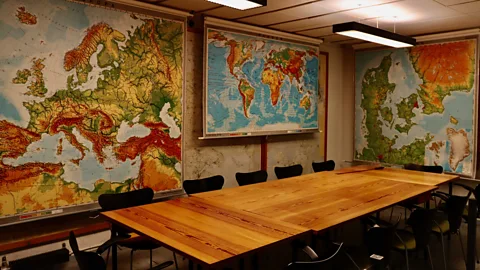 Adrienne Murray Nielsen
Adrienne Murray NielsenAnd that's why REGAN Vest is so unique. Other government bunkers exist, he explained, but have been updated, had contents removed, or aren't open to the public.
Thankfully World War Three didn't occur and the facility was only used for practice drills, though it remained on standby right until 2003, when it was eventually taken out of service. Nine years later, the long-held secret came to an end and then came almost decade-long preparations to preserve the bunker as museum.
Although I have memories of the Berlin Wall falling, as a 1980s child, the Cold War was an era I'd never really known. However, entering the bunker's "Situation Room" was a stark lesson. Military maps of Scandinavia and the Soviet Union covered the walls, ready for meetings that never took place.
"If you look at the map, and remember how the division in Germany was, then Denmark is a frontline country," explained Frandsen.
This was a time of fear and paranoia, but also preparedness. From basements in kindergartens to military forts, approximately 14,000 Cold War-era structures were erected across Denmark – and I was surprised to learn that another similarly large complex exists, called Regan Øst (East).
"I cannot tell you much more about that, because it's still in operation and it's kept secret," said Frandsen.
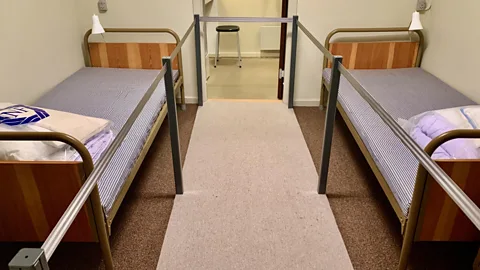 Adrienne Murray Nielsen
Adrienne Murray NielsenMoving along the rounded hallways of the residential quarters was somewhat disorientating. And but for the stairwells painted green, blue, yellow and orange, it would have been easy to get lost. I caught glimpses of a surreal life: austere rooms with bunk beds; hard hats still standing ready.
"This is the VIP room. There's carpet on the floor," Nørbach announced, as we entered a larger spartan bedroom with two single beds, its own bathroom and small office. These unlikely quarters were intended for Queen Margrethe. She had, in fact, visited once, I was told, and had even approved the wall paintings in her room.
The sleek lounge was perhaps the most vivid timepiece of all. Furnishings, light fittings and wallpaper, all emerald green, seemed straight from the pages of a 1970s magazine. And among the shelves of videotapes and books was a humorous touch: a copy of the James Bond novel "From Russia with Love". As we walked, I thought about the West's current geopolitical tensions with Russia and how the museum's opening seems particularly timely.
Our underground journey drew to a close inside the cafeteria where rows of identical black lampshades hung low over tables and photorealistic wallpaper depicted a forest scene. Piped birdsong had once played from a cassette machine, part of a surreal upgrade to improve the wellbeing of the few workers who occasionally came here, isolated deep beneath ground.
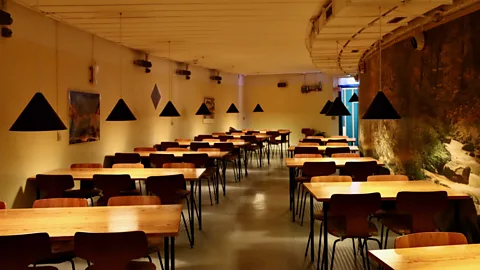 Adrienne Murray Nielsen
Adrienne Murray NielsenAfterwards, I lingered at the visitor centre where the exhibition delves further into Cold War history and society, and then entered the nearby Machinist's House, a typical yellow-brick property. It's been refurbished with 1980s decor and paraphernalia but was once home to an engineer who maintained the bunker. He'd lived there with his family until 2010, with a top-secret facility just beyond their backyard.
The fact it stayed hidden for half a century is remarkable and I was curious to know what locals thought about it.
"People can't wait to go down and finally see what it is," Frandsen answered.
"Many of them say, 'I knew it'," Nørbach laughed. "But don't believe them.
---
Join more than three million BBC Travel fans by liking us on Facebook, or follow us on Twitter and Instagram.
If you liked this story, sign up for the weekly bbc.com features newsletter called "The Essential List". A handpicked selection of stories from BBC Future, Culture, Worklife and Travel, delivered to your inbox every Friday.
